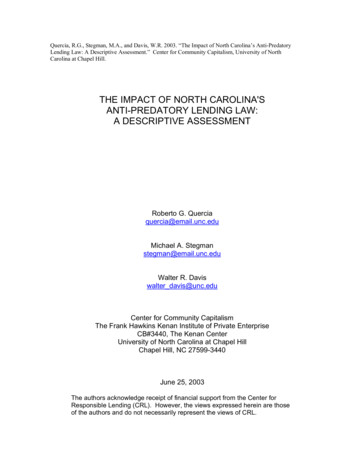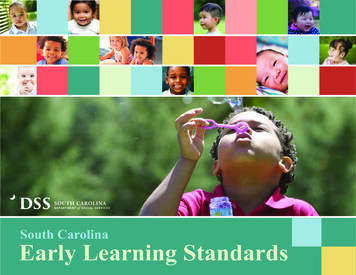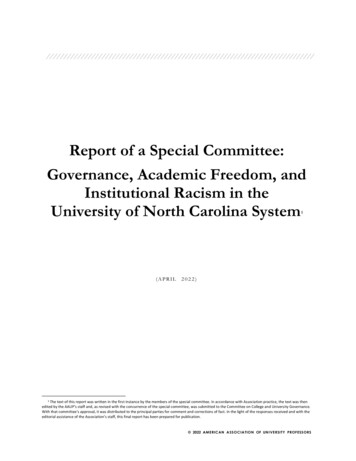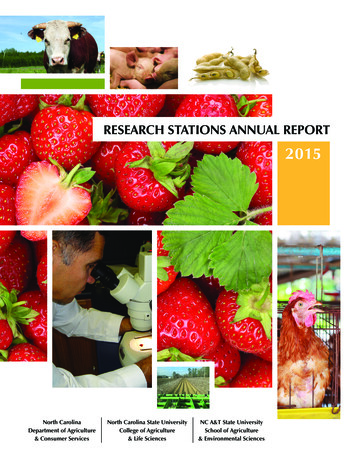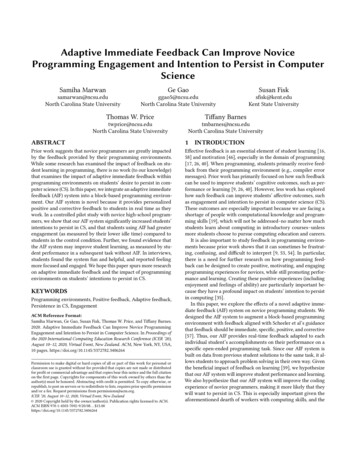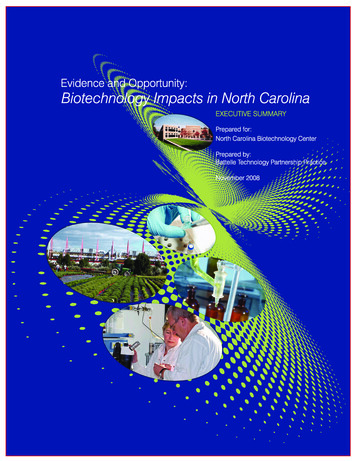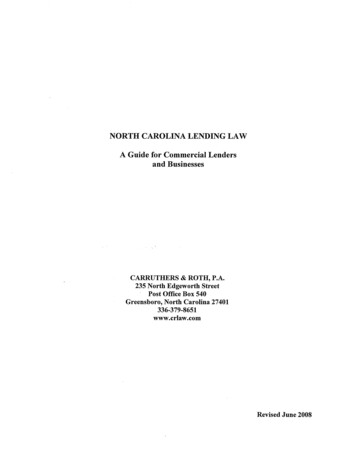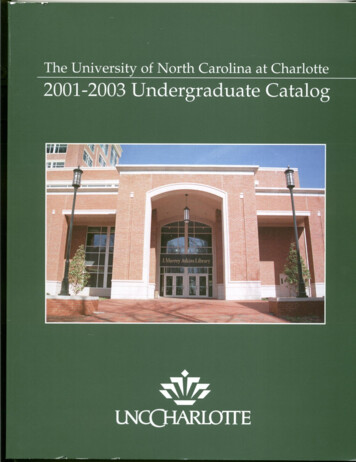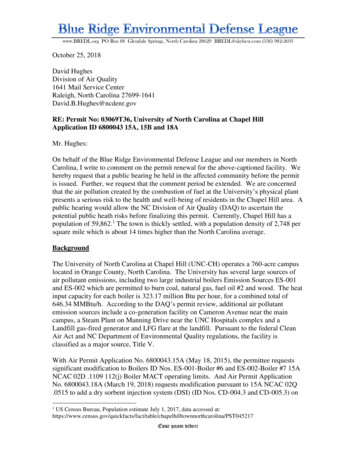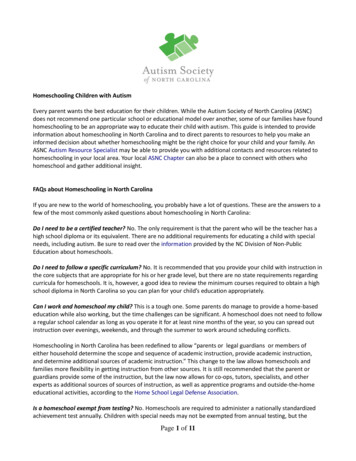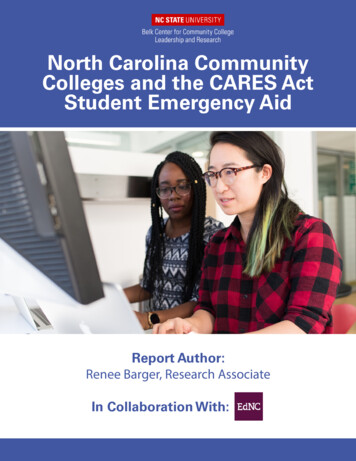
Transcription
North Carolina CommunityColleges and the CARES ActStudent Emergency AidReport Author:Renee Barger, Research AssociateIn Collaboration With:NC State Belk Center for Community College Leadership and Research - CARES ACT1
About this ReportThis report explores how North Carolina Community Colleges used the student emergency grant portion oftheir funding from the CARES Act. It examines colleges’ planning process for using the funds, how manystudents were helped, and what student needs still remain. The report serves as a tool for communitycollege leaders in determining how to use their remaining CARES Act funds and how to meet theirstudents’ needs going forward.About the Belk Center for Community College Leadership and ResearchWith a 10.86 million grant from the John M. Belk Endowment, the NC State College of Educationestablished the Belk Center for Community College Leadership and Research to enhance and strengthenits support of community colleges in North Carolina. The Belk Center seeks to develop and sustainexceptional community college leaders who are committed to advancing college access, the social andeconomic mobility of their colleges’ students, and the economic competitiveness of their regions. TheCenter conducts and disseminates research to address current and emerging student success challengesfacing community college leaders and policymakers in North Carolina and beyond.About EdNCEducationNC (EdNC) works to expand educational opportunities for all children in North Carolina, increasetheir academic attainment, and improve the performance of the state’s public schools. It provides residentsand policymakers with nonpartisan data, research, news, information, and analysis about the major trends,issues, and challenges bearing on education. It gathers and disseminates information employing the mosteffective means of communication, primarily through the Internet. In addition to the content distributed,EdNC encourages an active and connected community of those interested in education policy and practicethroughout the state.AcknowledgementsWe are grateful to our community college colleagues for their thoughtful and critical feedback on thedraft of this report: Sylvia Cini, Director, Special Projects, Central Piedmont Community College and CarolDisque, Vice President, Student Success, Alamance Community College. We thank our partners at EdNC,Nation Hahn and Molly Osborne, for their help in the development of this project. Additionally, we wantto acknowledge the Belk Center staff who assisted with editing and content development for this report:Audrey Jaeger, Jemilia Davis, Andrea DeSantis, Holley Nichols, Erin O’Quinn, and Kim Sepich.NC State Belk Center for Community College Leadership and Research - CARES ACT2
INTRODUCTIONIn response to the impact of a global pandemic onlocal communities, including education entities,the U.S. Congress passed the Coronavirus Aid,Relief, and Economic Security (CARES) Act inMarch 2020. The Act provided funding to highereducation institutions to create emergency grants tostudents “for expenses related to disruptions to theireducations due to the COVID-19 outbreak, includingthings like course materials and technology as well asfood, housing, health care, and childcare”.1The funding formula laid out in the CARES Actis based on the institutions’ full-time equivalentenrollment (FTE).2 The funding formula based 75%of the allocation on institutions’ FTE enrollment ofPell Grant recipients and 25% on FTE enrollmentof students who were not Pell recipients. Somecommunity college leaders have stated thatcommunity colleges, which serve a higher proportionof part-time students, were not supported equitablyby this funding formula.The CARES Act also restricted grants to studentswho were not enrolled exclusively in remote coursesbefore the coronavirus crisis. However, studentswho were previously taking courses online may stillexperience disruptions to their education due to thepandemic or have needs that fall under the eligibleexpenses included in the CARES Act.The Department of Education caused additionalcontroversy when it released guidance shortly afterthe CARES Act was passed which further restrictedthe students who were eligible to receive funding.The guidance limited the funding to studentswho were or could be eligible to receive aid fromfederal Title IV financial aid programs. This excludedundocumented and international students, studentswho were not making satisfactory academicprogress, and students who were not enrolled in aneligible academic program.Despite these restrictions, higher educationinstitutions were otherwise given great flexibilityin deciding how to distribute the grants. How theCARES Act funding is and was distributed by highereducation institutions varies across the countryand even within our state. The Belk Center forCommunity Leadership and Research is committedto equipping exceptional community college leaderswith resources as they address urgent needs. AsNC Community Colleges continue to face unchartedterritory, this report provides an overview of howthe CARES Act student emergency funding wasdistributed by North Carolina’s Community Collegesin an effort to provide a comprehensive referencepoint for decision-makers. This report includes anexamination of colleges’ planning processes forusing the CARES Act student emergency funds,1 U.S. Department of Education. (2020, April 9). Secretary DeVos Rapidly Delivers More Than 6 Billion in Emergency Cash Grants for College Students Impacted by CoronavirusOutbreak [Press Release]. reak2 Full-time equivalent enrollment is a calculation based on the sum of the credit hour load of all full-time and part-time students divided by the number of hours in a full-timecourse load.NC State Belk Center for Community College Leadership and Research - CARES ACT1
describes their methods of distribution, identifies how many students werehelped, and assesses what needs students still have. This report serves as aresource for colleges in determining how to use remaining CARES Act fundsand understanding what additional aid is needed for students.DATA & METHODSIn July 2020, the Belk Center worked with EdNC to identify and contactPublic Information Officers at each of the 58 NC Community Colleges. TheBelk Center requested documentation that summarized the planning processfor aid distribution, application forms, and outcomes data. There was alsoan opportunity to gather perspectives on their college’s planning process fordistributing the funds and on students with unmet needs, including those whowere not eligible for emergency grant funding under the CARES Act.Public Information Officers at 26 institutions offered information on theircollege’s planning process, and 33 provided insights on their students’unmet needs. These comments were used to identify both common themesand unique strategies for developing funding formulas and identifying andaddressing students’ unmet needs. This report also uses data from federallymandated public reporting to analyze how the funds are being spent and howmany students received a grant. Fifty-four colleges had started distribution oftheir funds at the time data was collected and issued these federal reports. Thefollowing overview summarizes key takeaways from the data gathered.HOW WAS THE FUNDING USED BY NORTHCAROLINA’S COMMUNITY COLLEGES?North Carolina’s Community Colleges received more than 60 million forstudent emergency grants. Allocations ranged from slightly over 100,000 tomore than 5 million. Almost 52,000 community college students in NorthCarolina have received a grant so far, and 73% of the student emergency grantfunds have been spent.The average grant that students received was 948 (see Figure 1). Among thestudents who were eligible for CARES Act grants, 62% had received a grant atthe time the Belk Center collected data (based on the colleges’ estimates of thenumber of eligible students).“This report serves as a resource for colleges indetermining how to use remaining CARES Actfunds and understanding what additional aid isneeded for students.”NC State Belk Center for Community College Leadership and Research - CARES ACT2
Figure 1. Number of Community Colleges by Average Grant Size and Percent of Funds SpentWhile the demographics of the recipients may change as more aid is granted, 18 community collegesprovided some demographic information on their current recipients. Including demographic datawith distribution trends is a key marker for ensuring the aid is distributed equitably. Demographicinformation will assist college leaders who are trying to determine whether they are equitably meetingstudents’ needs.On average, 69% of recipients were female.3 This is slightly higher than the percentage of studentsoverall who are women at those community colleges. Recipients were also more likely to be over 24years old than the general student population.4 Black students were also more likely to receive a grantrelative to the student population at colleges that reported data5, as were students who were enrolledfull-time (see Figure 2).6The larger portion of full-time students is unsurprising given the stipulation that funds must gotowards emergencies caused by “disruptions to campus operations” when campuses shut down andmoved to remote classes. Emergencies related to eligible expenses (food, housing, course materials,technology, health care, and childcare) may have affected both part-time and full-time students insimilar ways. However, full-time students’ emergency financial situations may be more likely to becaused by disruptions to campus operations. In addition, as will be discussed below, many collegesbased their funding formulas at least in part on credit hours. This may mean that part-time studentsare being underserved, because, on average, 67% of the student population at North Carolina’sCommunity Colleges is part-time.3 Gender data based on 12 community colleges4 Age data based on 13 community colleges5 Race/Ethnicity data based on 17 community colleges6 Enrollment status data based on 14 community collegesNC State Belk Center for Community College Leadership and Research - CARES ACT3
Figure 2. Grant Recipients by Race/Ethnicity andEnrollment StatusPlanning process.For community colleges that sharedcomments on their planning process, acommon theme was the multiple and oftencontradictory considerations decisionmakers juggled as they determined whenthe funds would be distributed and whichstudents would receive them.Among the factors respondents took intoconsideration during the planning processwere ensuring grants were received in atimely fashion and retaining some fundsfor future use (the CARES Act allowscolleges a year to expend all funding).Colleges also considered students’ mostpressing needs, which students were themost likely to withdraw, which studentswere the most impacted by moving toremote instruction, and what student needsmight remain after distributing the grants.Decision-makers at the colleges facedmany competing priorities; college leadersconsidered numerous factors in decidinghow to distribute the funds, but there wasno consensus on which of these factors wasa top priority across the colleges.“It was important for usto get the emergencyfunds directly intothe hands of eligiblestudents as quickly aspossible. The modelwe chose allowed usto accomplish this goalwhile simultaneouslygiving the institutionmore time to reflecton the future financialneeds of all studentswho were adverselyaffected by theCOVID-19 crisis.”“We [decidedwe] would retaina small amountof the funds touse during theSummer or Fallterms as any newcircumstanceswarranted theiruse.”“The funding formula wasbased on identificationof factors that were mostlikely to have impactedeligible students affectedby the pandemic and theconsequent disruptionsto campus operations.Factors taken intoconsideration included:enrollment status (halftime or more), work-lifebalance affected bycourses being movedonline, delay to programcompletion due towithdrawals related toCOVID-19.”NC State Belk Center for Community College Leadership and Research - CARES ACT4
Most colleges formed ad hoc committees and/orinvolved executive leadership in the decision-makingprocess. They also included subject matter experts in theplanning process, primarily from financial aid, finance andoperations, and student services departments. In addition,a wide variety of other departments were involved indecision-making, highlighting the importance placed ondeveloping an effective funding formula and distributionmethod. A few institutions also used outside resources,including recommendations from peer institutions,community partners, or an outside consultant.Some institutions included departments in planningdiscussions to address specific goals, such as: Targeting outreach to students about the emergencygrants:»» Marketing and Communications»» Student Engagement Preemptively addressing students’ unmet needs:»» College Foundation»» Development»» Community Partners Gaining a better understanding of students’ instructional needs:»» Technology Support»» Instructional Services»» Career Technologies ProgramPRACTICE IN FOCUSAlamance Community College included their Single Stop Coordinator in their planningcommittee, and later used Single Stop as a resource to assist students who had continuedunmet needs after receiving a CARES Act grant.Funding formulas.Colleges’ decisions about their formulas for determining how much aid each student receivedreflected the competing priorities they faced in the planning process. Most colleges (31)distributed their grants in one phase, while others had multiple phases (24) where they changedtheir eligibility criteria or their funding formula (see Figure 3).The most common funding formula was based on credit hours (see Figure 3). Credit hourformulas either classified students as full-time (12 or more hours) or part-time (12 or fewerhours) or further broke down part-time into ¾-time, half-time, or less than half-time enrollment.Students with higher credit loads received larger grants. Formulas based on credit hours weremost likely very popular because a student’s credit hours are the closest reflection of how muchthey were affected by disruptions to campus operations.NC State Belk Center for Community College Leadership and Research - CARES ACT5
Some colleges used a combination formula based on both credit hours and students’ expectedfamily contribution (EFC) from their FAFSA (the Free Application for Federal Student Aid). Thisallowed colleges to target students with more need, but colleges that required a FAFSA expendedtheir funds more slowly. This is most likely due to the time required for potentially eligible studentswho had not already completed a FAFSA to complete it. Using the third most common approach, 12colleges distributed grants in equal amounts to all their eligible students, which allowed them to getfunds to their students more quickly. However, the grants were not targeted at students with themost need, and those colleges have fewer remaining funds to support students as the pandemiccontinues.Of the 24 colleges that used multiple phases, 10 maintained the same funding formula to give anadditional grant to students. Other colleges combined multiple approaches to both send out grantsquickly and serve the neediest students. For example, 6 of the colleges that used a credit hour and/or expected family contribution (EFC) based formula later used an application. This allowed themto send out grants more quickly during their first phase and more accurately assess student needduring later phases. This was emphasized in one of the comments received on the planning process:“Central Piedmont will award funds two ways – formula and application. This dual approachensures that Central Piedmont maximizes awards to all students that meet the eligibilitycriteria, while targeting funding to students with greater financial need regardless of thereason for their need.”Figure 3. Number of Funding Phases and Funding Formulas Used by Community CollegesNC State Belk Center for Community College Leadership and Research - CARES ACT6
PRACTICE IN FOCUSSome colleges used unique funding formulas. Alamance Community College used an applicationduring their first phase, to target the neediest students first. The college then switched to aformula to ensure that all eligible students received some aid. Wilson Community College gave allstudents the same base amount, but also estimated additional needs if students’ had dependentsor experienced a COVID-related delay in completion. The college determined that studentsexperienced a delay in completion if they had dropped a course needed to complete their programdue to COVID. Southwestern Community College focused on students in Health Sciences fieldswho had to make up clinical hours from Spring semester during the summer in order to take theirlicensure examinations. These students would have graduated at the end of Spring semester andentered the workforce, and SCC used a portion of the funds to assist them with the unexpectedexpense of being in college months longer than anticipated.Applications and FAFSA.Most colleges (77%, or 43 colleges) required some form of application (see Figure 4). Theseapplications were used to confirm students’ eligibility and were sometimes also used to determinethe size of the grant each student received. Most applications were short, and for 10 colleges’, theapplication was only a form certifying eligibility. Certifications had questions regarding eligibilitycriteria for Title IV aid programs and the CARES Act, suchas:»» Have you completed a 2019-20 FAFSA?»» Were you registered for one or more face-to-faceor hybrid courses that were changed to remoteand/or online instruction during the Spring 2020semester?»» Check the appropriate boxes to describe thefinancial need related to the impact of theCoronavirus. (Options included: Food, Housing,Utilities, Course Materials, Healthcare, Childcare,Technology, Transportation, Tuition, Fees, Other)Applications usually included questions regardingeligibility and also required students to provide moreinformation on their financial need, and had additionalquestions such as:»» Please provide a brief, but specific, explanationand justification of why you need financial support.»» Please attach any supporting documentation thatyou have for your expense (bills, notices, letters).NC State Belk Center for Community College Leadership and Research - CARES ACT7
Some colleges used their applications to target their aid, and students received larger grants.However, fewer students at those colleges received funds. Colleges that only required an applicationfor certain phases or did not require an application were able to serve more students, but withsmaller grants.Figure 4. Application Required by College to Receive FundingUnder the Department of Education’s guidelines, colleges were required to confirm that studentswere or could be eligible to receive Title IV aid before issuing CARES Act grants to them. Collegeshad to decide whether or not to use the FAFSA or other documentation to determine if studentswere eligible. Requiring the FAFSA might exclude some potentially eligible students, but collegesmight not have had the time or data to determine eligibility themselves. Colleges that requiredthe FAFSA could also allow students to complete the FAFSA later (either after some grants hadalready been distributed or in a later phase), but that might affect how quickly they could distributegrants.NC State Belk Center for Community College Leadership and Research - CARES ACT8
Figure 5. FAFSA Required by College to Receive FundingNC State Belk Center for Community College Leadership and Research - CARES ACT9
UNMET NEEDSFor the community colleges that provided information on their knowledge of students’ continuingunmet needs, lack of eligibility for the CARES Act aid emerged as a major reason students stillhad unmet needs. Many students’ emergencies were unrelated to the campus disruption, suchas job loss or furlough. Students who were taking all of their classes remotely before the start ofthe pandemic were also often mentioned as an underserved group.“Based on federal guidance,we know that there were manystudents who did not qualifybecause they were online only,DACA or undocumented, orbecause they did not file aFAFSA.”“A number of students requestedfunds whose “emergencies” wererelated to their own or a familyjob loss, child care expenses, orother issues not related directly tothe College’s disruptions causedby COVID-19 adjustments. Thosestudents did not qualify for CARES/HEERF student emergency grants.”The biggest challenges students faced besides job loss were in the same categories as theCARES Act’s eligible expenses, lack of technology and internet access, housing and utilities costs,food insecurity, medical needs, and childcare. Many colleges were able to offer an additional grantor non-financial support (hotspots, technology loans, and food) from another source of funding.The funding most often came from the college’s foundation, but some colleges relied on newprivate gifts, community partners, or Finish Line Grants.“The largest non-monetary need noted was access to a location thathad steady internet functionality as some students lived in areas whereconnection was either slow or non-existent.”“Students are struggling with unemployment or having their employersreduce the number of hours they are able to work. Applications indicatedthat students are struggling with housing instability, hunger, tuitionpayments, utilities, and technology.”“Additional needs were technology (lack of computer or internet access),food expenses and living expenses, some students became homeless duringthe pandemic.”NC State Belk Center for Community College Leadership and Research - CARES ACT10
PRACTICE IN FOCUSIn order to offer students more flexibility, Gaston College used CARES Act institutional funds todevelop a condensed semester program called GC Express. The program allows a small cohortof students to complete online classes in five week blocks for the Fall 2020 semester. CARESAct Funds will be used to provide GC Express students with a 1,700 direct grant and a laptop.CONCLUSIONNorth Carolina’s Community Colleges faced many competing priorities as they assessedhow to use their student emergency grant funding from the CARES Act. Both the commentsshared by the community colleges and the analysis of the financial data revealed that decisionmakers also chose to focus on different goals based on their students’ needs. The followingrecommendations can be used by colleges in distributing their remaining CARES Act funds,creating more student emergency grants from the institutional funds from the CARES Act, ordeciding how to use future sources of funding to support students during the pandemic. Insharing the following recommendations, we acknowledge that not all recommendations willapply to all colleges, based on what their priorities are.Recommendations»» Consider including a wide variety of departments at the college in the planning process,including departments that can assist with reaching out to students about grants, planningfor additional support or resources for students, or understanding students’ instructionalneeds in a remote environment.»» Identify and work with community partners that may be able to provide additional financialand/or non-financial support to students. Colleges can also refer students directly tocommunity partners where they can receive support.»» For colleges concerned about issuing grants as quickly as possible, distributing grantsin equal amounts or using a simple formula based on credit hours would be the mostefficient route. Distributing grants without requiring an application or using a shortcertification would ensure quick distribution as well.»» Applications can be useful in targeting aid to the neediest students or ensuring thatstudents’ specific needs are addressed.»» A multi-phase approach allows colleges to both ensure that all eligible students receivesome aid and the neediest students receive additional aid, such as:»» Combining equal amounts or a simple formula in the first phase with anapplication in another phase.»» Reversing the order of the dual approach by using an application first and thenmoving to a formula-based approach to ensure that the neediest students receiveaid first.NC State Belk Center for Community College Leadership and Research - CARES ACT11
NC State Belk Center for Community College Leadership and Research - CARES ACT 5 Most colleges formed ad hoc committees and/or involved executive leadership in the decision-making process. They also included subject matter experts in the planning process, primarily from financial aid, finance and
